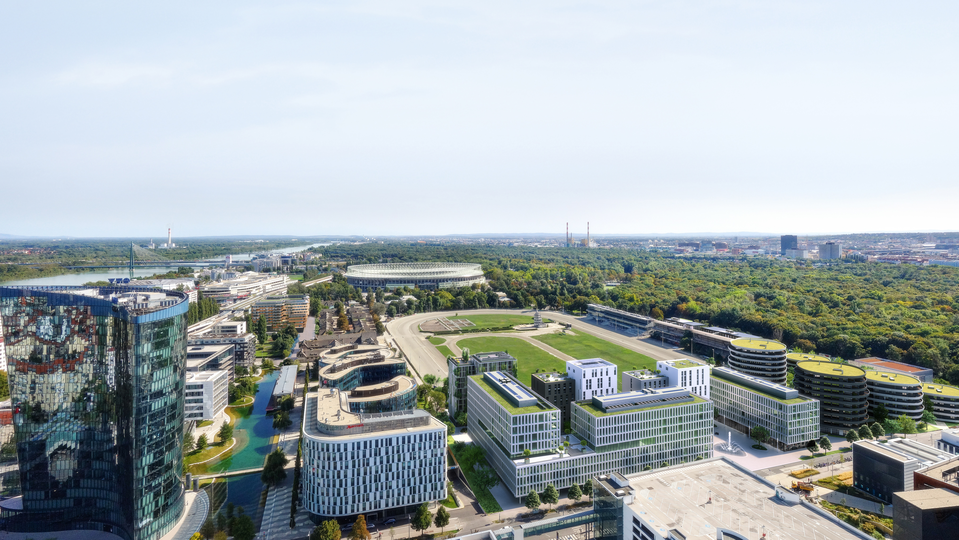-
Projects
Construction site lexicon
Construction site terms simply explained
ABSORPTION WELL
Swallow wells (also infiltration wells) are shafts in the ground that are used to infiltrate water. In the case of the Grünblick construction site, the groundwater table is higher than the lowest point of the excavation pit. Therefore, it is necessary to lead the groundwater out of the excavation area. For this purpose, extraction and absorption wells are used.
BORED PILE
The bored pile is a pile made of concrete. It is used in soils with low bearing capacity in order to transfer the building forces to the deeper subsoil with higher bearing capacity.
CIVIL CONSTRUCTION
Civil engineering involves all construction activities that take place underground, i.e. below the earth's surface. This includes, for example, the construction of traffic routes (roads, bridges, tunnels, railways, waterways), cellars, canals or foundations.
CLEANLINESS
Cleanliness, clean layer, or subgrade concrete is a thin layer of concrete located between the bottom of the excavation and the building foundation. Its primary purpose is to provide a clean, level and dry surface for subsequent work.
CONNECTION REINFORCEMENT
Connection reinforcement is reinforcement (see reinforcement) that protrudes from the components that have already been concreted. Other structural members can be connected to it subsequently.
DEPTH PROBES
Deep probes (also called geothermal probes) are U-shaped plastic pipes inserted vertically into the ground. They are filled with the so-called brine, a water-antifreeze mixture. The brine circulates in the pipes and absorbs the heat stored in the ground, which is then transferred to the geothermal heat pump.
DIAPHRAGM WALL
A diaphragm wall is a reinforced concrete wall in the subsoil that protects the excavation pit from collapse (excavation pit protection). It remains in the ground and can later be used as a load-bearing wall of the building. Depending on the requirements, it can also be designed to prevent groundwater from entering the excavation pit and later the basement of the building (tight design).
EXCAVATION SUPPORT
If an excavation pit is created, it must be secured in accordance with local conditions. The excavation support prevents, for example, the collapse of the excavation pit due to landsliding soil, but also the subsidence of neighboring buildings.
FOUNDATION
A foundation is the transition from the structure to the ground. The task of the foundation is to absorb loads from the structure and transfer them to the subsoil without damage. This can be done by various measures or a combination of measures, such as base plates, drilled piles, strip footings, etc. A combined pile and slab foundation is used at the Grünblick site.
HIGH CONSTRUCTION
Building construction refers to all components of structures that are located on or above the earth's surface. This includes residential and administrative buildings, industrial production facilities, sports and leisure facilities, and in some cases bridges and locks.
REINFORCEMENT
Reinforcement is the strengthening of concrete with steel. This increases the load-bearing capacity and load-bearing strength of the concrete or concrete components. The reinforcement itself is usually made of steel. If the concrete is now poured into the reinforcement or into the steel grid (reinforcing steel), the result is reinforced concrete. This is now able to withstand various tensile forces. (see also connection reinforcement)
SINKING
Sinking means building a shaft into the depths. In miners' language, it refers to the construction of vertical cavities, for example, for the development of deposits. ANCHOR DRILLING Anchors are used to secure the diaphragm wall against the pressure of the earth (earth pressure) and water (water pressure) behind it. This prevents the diaphragm wall from tipping forward during construction. Once the basement slabs are in place, the diaphragm wall is braced by them and the anchors can be removed again.
SPECIAL CIVIL ENGINEERING
Like civil engineering, special civil engineering deals with construction activities below the ground line. However, special civil engineering is always used when particularly difficult conditions are encountered. For example, challenging terrain (slopes, terrain jumps, high groundwater levels) or special soil compaction and sealing, as in the construction of a high-rise building in an already densely populated area, require the use of special civil engineering.
Do you have any questions?
Feel free to contact us at livedabei@value-one.com
The Live dabei! Team is there for you.

